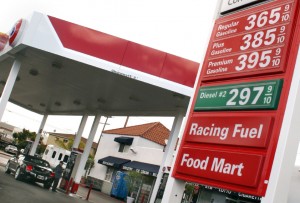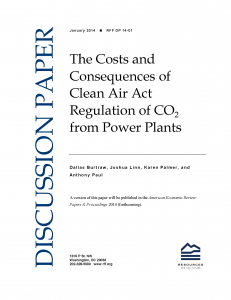RFF on the Issues: Crude oil exports; Destroying ivory stockpiles
Crude Oil Exports
A pair of Senate Democrats has called for a “comprehensive analysis” of the potential effects of lifting the ban on US crude oil exports, including how it might impact gasoline prices. Experts predict that crude oil producers will “struggle to find a market” for their product by the end of the year due to the export constraints and inadequate domestic processing and distribution capacity.
According to new research by RFF’s Stephen P.A. Brown, Charles Mason, Alan Krupnick, and Jan Mares: “US refineries are better suited to process heavy crude oil, while refineries in other countries are better suited to process light crude oil. As a result, lifting the ban on US crude oil exports would allow for a more efficient distribution of crude oil among refineries in the Western Hemisphere and elsewhere in the world” and, ultimately, reduce gas prices. Read the complete RFF issue brief here: Crude Behavior: How Lifting the Export Ban Reduces Gasoline Prices in the United States.
Ivory Stockpiles: Will Destroying Them Really Help Stop Poaching?

Source: Megan Coughlin / flickr
Just over five years ago, sanctioned auctions of ivory stockpiled in Botswana, Namibia, South Africa, and Zimbabwe raised more than $15 million for elephant conservation.
Now, Tanzania is set to destroy $50 million of ivory stockpile, following the lead of the US, France, Hong Kong, and China. The US is also taking steps to further restrict ivory trade, banning the import, export, and resale of ivory, and imposing more stringent guidelines for the sale of antique ivory.
Ivory poaching has continued to be a problem since the 1989 ban on international trade in ivory, codified in the Convention on International Trade in Endangered Species of Wild Fauna and Flora (CITES). Since then, we have seen several back-and-forths on the role of legal ivory sales, as of government stockpiles obtained through confiscation and natural wildlife management.
The competing ideas boil down to this question: do the sales of legal stockpiles affect demand more than supply? Governments today are making a big bet on the former. Read More
Resources Magazine: Forever Ours? The Challenges of Long-Lived Environmental Problems
Pharmaceutical residues in waterways, industrial waste lingering in soils, space debris in orbit for hundreds of years, nuclear waste requiring management for thousands of years, and greenhouse gases affecting carbon cycles subject to geologic time-scales: these pollutants are the potentially long-lasting side effects of modern, growing economies and the attainment of ever-better standards of living.
Policymakers seek to protect the public by balancing the costs and benefits of mitigation, remediation, and other strategies to control these problems. Unlike the case of many shorter-lived pollutants, however, these long-lived contaminants are particularly vexing for regulators and citizens alike. Indeed, these long-lived environmental issues could be thought of as a class of problems that are “forever ours,” unique because of their almost unrestrained temporal scale. The contaminants may be present in trace amounts or have other effects that cause only small damages today; thus the public may not feel urgency to take action. But the contaminants may persist and, even worse, accumulate over time to create much greater damage, although in a perhaps very distant future. Some pharmaceutical residues, certain greenhouse gases, and space debris that self-collide to produce yet more debris are examples of pollution with cumulative effects that can worsen to create significant future harm.
Read the rest of this article.
Ending the Export Ban: What It Means for US Gasoline Prices
 Last week, top Democrats on the Senate Energy and Natural Resources Committee requested a comprehensive review of what would happen—in terms of energy prices, consumer prices, and more—if the US were to lift its ban on oil exports. In a new RFF issue brief, together with Stephen Brown, Charles Mason, and Jan Mares, we tackle one of the most talked-about questions: What would happen to domestic gasoline prices were that export ban to be lifted?
Last week, top Democrats on the Senate Energy and Natural Resources Committee requested a comprehensive review of what would happen—in terms of energy prices, consumer prices, and more—if the US were to lift its ban on oil exports. In a new RFF issue brief, together with Stephen Brown, Charles Mason, and Jan Mares, we tackle one of the most talked-about questions: What would happen to domestic gasoline prices were that export ban to be lifted?
The export ban has been a hot topic ever since the rapid increase in oil production of light sweet crude in the Bakken, Eagle Ford, and Permian basins began to cause bottlenecks in the US oil distribution system and mismatches between refinery capabilities and the characteristics of the oil being produced. Although the United States has considerable oil refinery capacity, most of it is currently maximized to refine medium crudes or heavy, sour crude of the kind generally produced in the United States and imported. And its distribution system has increasingly had to rely on rail and water conveyance with the pipeline system playing catch up. Read More
RFF ON THE ISSUES: Changes to Endangered Species Protection; Carbon Tax Impact
Changes to Endangered Species Protection
Recently, Republicans in Congress proposed a series of changes to the Endangered Species Act (ESA). Their report recommends transferring more regulatory power to states and “curtail[ing] litigation from wildlife advocates”
In a recent issue of Resources magazine, Lynn Scarlett, Rebecca Epanchin-Niell, and Matthew McKinney write that while the ESA faces various challenges, it also “provides an effective framework to meet these challenges, particularly as efforts pivot away from a species-by-species approach and toward incorporating species protection within larger, landscape-scale efforts that use incentives to engage private landowners and nonprofit partners.” New strategies for increasing the effectiveness of the ESA were also discussed at this RFF First Wednesday Seminar (video available).
This Week in the RFF Library Blog
Each week, we review the papers, studies, reports, and briefings posted at the “indispensable” RFF Library Blog, curated by RFF Librarian Chris Clotworthy. Check out this week’s highlights below:
Hydraulic Fracturing and Water Stress: Water Demand by the Numbers
America’s oil and gas rush is depleting water supplies in the driest and most drought-prone areas of the country, from Texas to California, new research has found. Of the nearly 40,000 oil and gas wells drilled since 2011, three-quarters were located in areas where water is scarce, and 55% were in areas experiencing drought, the report by the Ceres investor network found. — via The Guardian
Birth Outcomes and Maternal Residential Proximity to Natural Gas Development in Rural Colorado
Pregnant women living in areas with a large number of oil and gas wells within 10 miles of their home are more likely to give birth to children with congenital heart defects compared with women not exposed to any wells, according to a limited new study. — via Environmental Health Perspectives
Implementation Plan for The National Strategy for the Arctic Region
The Obama Administration released the Implementation Plan for the National Strategy for the Arctic Region, itself released in May 2013. The main lines of effort of the Strategy and the Implementation Plan are: (1) to advance US security interests; (2) to pursue responsible Arctic region stewardship, including an increase in scientific research related to the region; and (3) to strengthen international cooperation… — via Green Car Congress
Exploring Climate Finance Effectiveness
Ensuring that climate finance is used effectively will help to maximise its impact. The effectiveness of climate finance can be defined as the extent to which an activity attains its stated aims. These aims can vary, depending on the source of climate finance and how it is channeled. There are therefore different views on what “effective” climate finance is… — via OECD
Oil Sands Emissions Greatly Underestimated: Univ. of Toronto Study
Results from a new modeling assessment of contamination in the Athabasca Oil Sands Region (AOSR) suggest that officially reported emissions of polycyclic aromatic hydrocarbons (PAHs) in that region have been greatly underestimated… — via Proceedings of the National Academy of Sciences
For more from the RFF Library blog, click here.
Best of the Above
It looked like a reverse make-me-do-it – President Obama in his State of the Union address saying don’t-do-that-again to some of his most committed supporters. An array of groups had written to him just two weeks earlier about the failings of an “all of the above” energy policy, and the first words in his speech regarding energy and the environment were, “The “all of the above” energy strategy I announced a few years ago is working…”
This high-visibility affirmation came after Presidential counselor John Podesta had already sent a response to the groups that never mentioned “all of the above.” It touched on the subject only in a single phrase, saying the President “understands the need to consider a balanced approach to all forms of energy development, including oil and gas production.”
What kind of balance was he talking about – volumes, BTU’s, dollars, carbon? Balanced is good in concept, much better than unbalanced, but otherwise undefined. A default generic meaning, seen in much media coverage, is equal treatment of all sides. But presenting as equal things that are most definitely not is not good policy, news or energy. In a market where individual fuels cover vastly different portions of their costs, a strategy to treat them all the same is highly biased. It lets climate-forcing fossil fuels into the mix without regard to their earth-transforming impacts.
Who Benefits from Flexible GHG Rules?
 US climate policy is unfolding under the Clean Air Act. Mobile source and construction permitting regulations are in place. The US Environmental Protection Agency (EPA) has developed draft final rules for the performance of new power plants. Most important, EPA and the states will soon determine the form and stringency of the regulations for existing power plants responsible for roughly 40 percent of the nation’s carbon dioxide emissions.
US climate policy is unfolding under the Clean Air Act. Mobile source and construction permitting regulations are in place. The US Environmental Protection Agency (EPA) has developed draft final rules for the performance of new power plants. Most important, EPA and the states will soon determine the form and stringency of the regulations for existing power plants responsible for roughly 40 percent of the nation’s carbon dioxide emissions.
Achieving President Obama’s 2020 emissions goals will depend largely on how regulations for existing power plants are designed and implemented under the Clean Air Act. Recently, the president asked EPA to seek out a regulatory system that, “to the greatest extent possible,” incorporates market-based instruments, performance standards, and regulatory flexibility. This flexibility could be accomplished in a number of ways.
How the Cold Snapped Clean Currents
 Renewable power retailer Clean Currents will no longer provide electricity to its 15,000+ customers, as it had reliably done since 2005. Co-founders Gary Skulnik and Charlie Segerman announced on Friday that the company has shut its doors forever. Why? In a blog post to its customers, the duo explains that the recent severe cold weather is to blame:
Renewable power retailer Clean Currents will no longer provide electricity to its 15,000+ customers, as it had reliably done since 2005. Co-founders Gary Skulnik and Charlie Segerman announced on Friday that the company has shut its doors forever. Why? In a blog post to its customers, the duo explains that the recent severe cold weather is to blame:
“[T]he recent extreme weather, which sent the wholesale electricity market into unchartered (sic) territories, has fatally compromised our ability to continue to serve customers.”
Their reasoning piqued my curiosity. (And I’m not the only one—the Washington Post followed up with the firm’s co-founders yesterday.) What does it mean for the wholesale electricity market to go “into uncharted territories”? Could a few days of record prices put the entire company out of business?
RFF ON THE ISSUES: Energy and Climate in the State of the Union
Energy and climate in the State of the Union
Last week’s State of the Union address emphasized gains made in the energy sector as well as future promises of development and change. Below are highlights of recent analysis by RFF researchers on the various policy ideas mentioned in President Obama’s address.
On energy independence:
- Joel Darmstadter and Roger Sedjo on the significance of achieving US energy independence.
On natural gas:
- Richard Morgenstern, Arthur Fraas, and Winston Harrington on the use of natural gas for light-duty vehicles.
- Stephen Brown and Alan Krupnick on natural gas as a bridge to a low-carbon future.
- Alan Krupnick on whether natural gas vehicles will become a fuel choice for America’s vehicle fleet.
On fuel efficiency standards for cars and trucks:
- Joshua Linn on how vehicle manufacturers respond to tightening fuel economy standards.
- Virginia McConnell on implications of the new CAFE standards and complementary policies (and the dual goals of reducing fuel consumption and greenhouse gas emissions).
On renewable energy:
- Joshua Linn and Clayton Munnings on designing renewable electricity policies that reduce emissions.
- Results from a survey by RFF University Fellow Jon Krosnick on the public’s attitudes on climate change and clean energy.
On greenhouse gas regulations:
- Dallas Burtraw and Matt Woerman on the importance of flexibility in greenhouse gas regulation.
- Nathan Richardson on the impact of the US Environmental Protection Agency’s new source performance standards for coal plants.
- Dallas Burtraw, Joshua Linn, Karen Palmer, and Anthony Paul on analyzing the costs and consequences of regulating power plant emissions.
On climate change:
- Survey results from RFF, Stanford University, and USA Today on assessing American attitudes toward global warming.
- Brian Flannery on negotiating a post-2020 climate agreement.
On issues not mentioned in the speech:
- Joel Darmstadter and Alan Krupnick on the consequences of the Keystone XL rejection.
- Survey results from RFF, Stanford University, and USA Today on American opinions regarding the proposed Keystone pipeline.

 Subscribe; to our RSS Feed
Subscribe; to our RSS Feed Tweets by @RFF_org
Tweets by @RFF_org 
Recent Comments